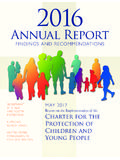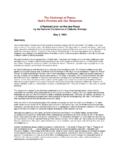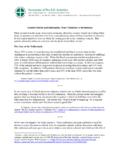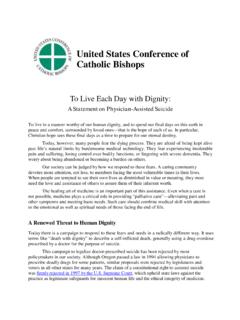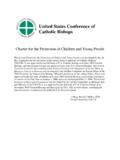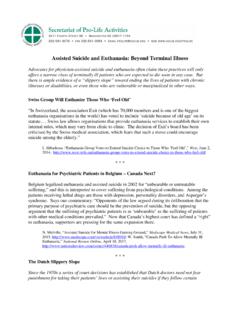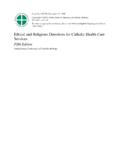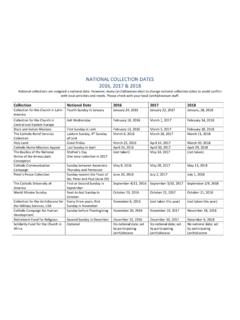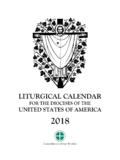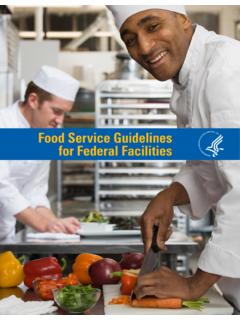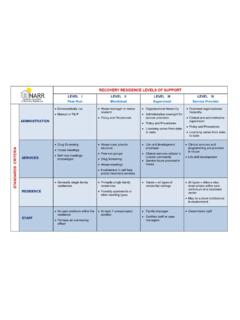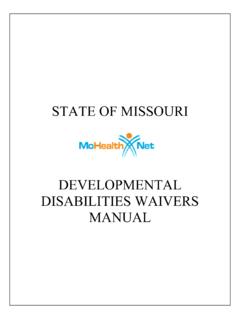Transcription of Catholic School FACT Sheet - USCCB
1 1 Catholic School FACT Sheet Part I: Fast Facts for Catholic School Advocates In 2016, about million children attended public schools; million children attended private schools, with almost 2 million in Catholic schools. (NCEA) There are 151,101 staff teaching in Catholic schools; are Religious or Clergy. (NCEA) The student/teacher ratio in Catholic schools is 13:1.(NCEA) 99% of students who attend Catholic high School graduate. Of those, 86% attend 4-year colleges. (NCEA) Currently, 5 of the 8 Supreme Court Justices went to Catholic School . ( ) Since 1994, the percentage of schools with boards has increased from to a current level of (NCEA) The minority population accounts for of the Catholic School population ( Latino; Black/African American; Asian American; Multiracial).
2 (NCEA) of Catholic School students are not Catholic . (NCEA) 45% of Catholic schools in the United States participate in Federal Nutrition Programs, which provide over 270,000 free meals to children daily. The mean cost per pupil at Catholic schools is $5,847; the national per pupil average is $12,608). (NCEA; National Center for Education Statistics) Catholic schools provide over 24 billion dollars a year in savings for the nation. (NCEA) Part II: Faith Life and Formation ACRE Testing and Catholic Schools o 2010 study, What Do Our Children Know About Their Faith by Dr. John Convey.
3 O Dr. Convey chronicled the success of Catholic schools in teaching the Catholic faith drawn largely from testing data from the Assessment of Catechesis/Religious Education or ACRE1. o The report indicated that students in Catholic schools, both Catholics and non-Catholics, score higher on faith knowledge than do students from parish programs. 1 McDonald, Dale, PBVM. and Margaret Schultz, Annual Statistical Report 2013-2014, National Catholic Educational Association (NCA), 2014 2 John J. Convey, What Do Our Children Know About Their Faith?
4 Results from the ACRE Assessment, NCEA: Washington, DC, 2010. 2 o Dr. Convey gave various examples of ongoing success in religious education and catechesis in schools, including examples from different places: Dioceses of Arlington, St. Petersburg, Houma-Thibodaux, and the Archdioceses of Cincinnati and Part III: Academic and Civic Benefits Catholic schools are good for the republic. Catholic schools tend to operate as communities rather than bureaucracies, which links to higher levels of teacher commitment, student engagement, and student achievement. 3 The Catholic School climate, mission, and purpose positively impact student achievement and attendance.
5 4 A faith-based orientation builds coherence and integration of schools and School Catholic Schools help students achieve academically In Catholic schools, the student achievement gap is smaller than in public In Catholic schools, overall academic achievement is higher. 7 In Catholic schools, student math scores improve between sophomore and senior Latino and African American students in Catholic schools are more likely to graduate from high School and college. 9 Students with multiple disadvantages benefit most from Catholic 2 Convey, p.
6 117. 3 Marks, G. (2009). Accounting for School -sector differences in university entrance performance. Australian Journal of Education, 53, 19-38. 4 Bryk, , Lee, , & Holland, (1993). Catholic Schools and the Common Good. Boston: Harvard University Press. 5 Ibid. 6 Jeynes, (2007). Religion, Intact Families, & the Achievement Gap. Interdisciplinary Journal of Research on Religion, 3, 1-24; Marks, , and Lee (1989). National Assessment of Educational Proficiency in Reading 1985-1986: Catholic and Public Schools Compared. Washington, DC: National Catholic Educational Association. 7 Coleman, J.
7 , Hoffman, T., & Kilgore, S. (1982). High School Achievement: Catholic and Public Schools Compared. NY: Basic Books; Sander, W. (1996). Catholic Schools: Private and Social Effects. Boston: Kluwer Academic. 8 Covay, E., and Carbonaro W. (2010). After the Bell: Participation in Extra-Curricular Activities, Classroom Behavior, and Academic Achievement. Sociology of Education, 83(1), 20-45. 9 Jeffrey Grogger and Derek A. Neal; "Further Evidence of the Effects of Catholic Secondary Schooling, Brookings-Wharton Papers on Urban Affairs, 2000, pp. 151-93. 10 Derek A. Neal; "Measuring Catholic School Performance.
8 " Public Interest, 1997, (127), pp. 81; Derek A. Neal; "The Effects of Catholic Secondary Schooling on Educational Achievement."Journal of Labor Economics, 1997, 15(1, Part 1), pp. 98-123; Evans, 3 The poorer and more at-risk a student is, the greater the relative achievement gains in Catholic Catholic schools unlock the intellectual potential of the young people they serve while forming them for a personal and living encounter with Jesus Christ: Catholic School students are more likely pray daily, attend church more often, retain a Catholic identify as an adult, and donate more to the Church.
9 (Sander, 2001, p. 9) Students in Catholic schools demonstrate higher academic achievement than their public School peers from similar socioeconomic backgrounds. (Coleman & Hoffer, 1987; Greeley, 1982; Sander, 1996, p. 544) The more disadvantaged a child is, the greater the relative achievement gains he or she experiences in a Catholic School . (York, 1996) The achievement gap between students of different racial and/or socioeconomic backgrounds is significantly smaller in Catholic schools. (Jeynes, 2007, p. 2) 99% of Catholic School students graduate from high School on time, and 86% of Catholic School graduates attend college.
10 (McDonald & Schultz, 2016) A black or Latino child is 42% more likely to graduate from high School and times more likely to graduate from college if he or she attends a Catholic School . (Neal, 1997, p. 108) The Catholic School emphasis on lived Christian community stimulates parental engagement: Inner-city Catholic School parents report taking an active role in their children s education, and they believe that participating in the Catholic School community represents an opportunity to break the cycle of poverty. (Stewart, Wolf, et. al, 2009) Latino Catholic School parents believe their children are more motivated, more focused, and working harder since enrolling them in a Catholic School .
